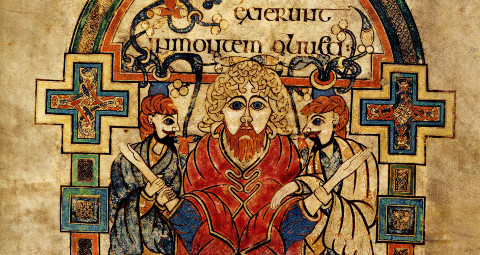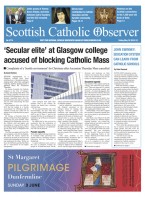BY Amanda Connelly | May 18 | ![]() 0 COMMENTS
0 COMMENTS ![]() print
print

Turning to a new page in Scottish Irish relations
The historian behind the guide to The Book of Kells tells AMANDA CONNELLY why Scots should celebrate it too
On St Patrick’s Day, March 17, people of Irish descent across Scotland celebrate their Irish roots with festivals, Masses and family gatherings, renewing the connection between their Catholic Faith and genealogy. Many know of the Celtic saints who brought the Faith to Scotland from Ireland, key among them being St Columba.
Yet few may know of an artefact of great significance in the annals of the history of the Faith in both Ireland and Scotland: the 1,200-year-old Book of Kells.
A beautifully illuminated medieval representation of the Gospels of Matthew, Mark, Luke and John, the Book of Kells proclaims the Word of the Lord and witnesses the shared roots of the Faith in these isles.
Now the ancient manuscript, painstakingly painted by monks around 800AD, has been brought to life for modern audience with the help of historian Bernard Meehan, author of The Book of Kells: Official Guide.
“Basically, the Book of Kells is a copy of the four Gospels,” Mr Meehan explained. “It was written round about the year 800, but we don’t know exactly when. It’s likely that it was begun on Iona, which is now in Scotland, but when it was written was much more like part of Ireland.”
Mr Meehan noted that within a few years the book was moved to Kells in Meath, north of Dublin. Today it is on display in the library of Trinity College Dublin, as an ‘emblem’ of the ‘great depth of Irish culture.’
Yet the book’s links to Scotland should not be overlooked.
“It was done by monks following St Columba, as he’s usually called in Scotland, or St Columbkille as he’s called in Ireland,” Mr Meehan said, explaining how the saint left Donegal in the 560s, moving to the Hebrides and Iona.
“He died in 597. Books were made by him and by his people. Very few of them survived,” he added, explaining how Viking raids and illness devastated the island and the monks.
He said that while the Book of Kells had become an ‘icon of Irish nationality’ and ‘an emblem of the great depth of Irish culture and the proficiency of Irish craftsmen and scribes and scholars in the early Middle Ages,’ the same argument is rarely heard in Scotland.
He continued: “Quite why that is I don’t know. Modern politics have kind of gone against it, but there’s a very strong Scottish connection with Iona itself and also with Dunkeld.
“Columba himself probably founded Dunkeld and his relics were moved there in the mid-ninth century, and moved back again to Ireland at the Reformation, then lost.
“But there’s a number of sites in Scotland which still indicate the presence of Irish monks around this time.
“That is the connection,” he added. “There’s no certainty about where [the book] was made. I mean it was in Kells certainly from the 11th century, almost certainly before, then there’s an awful lot of guesswork involved.”
Mr Meehan noted that the historical sources ‘aren’t all that fantastic for this period.’
He continued: “They’re not very detailed and you have to draw conclusions out of what you have. But certainly I believe that the way it started was on Iona.”
He noted that there is one particular section of the book that seems ‘just a bit different from the rest’ and might have been done at Iona. Despite the Viking raids, not all of the monks left, and there was a lot of ‘coming and going between Iona and Ireland, and between Iona and the Picts, and between Iona and Northumbria.’
“Lindisfarne for example is something that was founded from Iona, so it’s got a very strong missionary movement heading out from Iona in both directions,” he said. “Scholarship, art, book production, spreading the message of the Gospel.”
Scottish-born Mr Meehan, a native of Edinburgh with a background rooted in the Irish migration during the 19th and 20th centuries, moved to Ireland in 1976 just as he was finishing a PhD on 11th and 12th-century manuscripts made in the north of England. It seemed natural that his interest should turn to the earlier Book of Kells. “There’s something hugely exciting about getting in your hands something that was made as long ago, there’s a real buzz out of it for somebody like me,” he said.
He took an interest in the book and has now written the official guide, which he describes as ‘the second edition of something I wrote in 1994, which I called an introduction.’
It marks his third book on the Book of Kells; his second was published in 2012.
“Why it’s something that an awful lot of people have known about is it’s not so much that it’s a copy of the Gospels or that it’s a medieval copy of the Gospels, but really that there is nothing like it that’s so richly decorated,” he explained. “Many medieval copies of the Gospels, they would only have the opening word decorated.
“For example, the opening of Matthew’s Gospel is ‘liber’ the Latin for book. So they’d do a very ornate version of the word ‘liber’ and might add an image of what they thought Matthew the Evangelist looked like, but that was often as far as it went and they would emphasise certain words at the beginning of certain chapters.
“But what’s really unusual about the Book of Kells is it’s of a very, very high standard and extremely complex.
“Unusually every page is decorated, and it has drawings of animals and all sorts of different things in-between the lines, or forming initials to the letters.
“That kind of thing is very unusual… it’s a very, very attractive thing to work on for someone who’s interested in medieval manuscripts.”
Mr Meehan considers the book as an object of study ‘inexhaustible,’ and said ‘every time you look at it you see something you’ve not noticed before.’
This ornate design can cause some ambiguity over its meaning, however. He explained that he was ‘absolutely certain’ people in the ninth and 10th centuries would have ‘read’ the illustrations in the way we read text, and it would have been ‘quite clear to them what was intended’.
“Now we look at the Latin and we have to translate it. You look at the Latin and immediately it’s not something that most people can read, so there’s a difficulty there in comprehension and there’s just so many uncertainties about how the book was put together, the different scribes, the different artists,” he said. “But what exactly did they mean, or are we getting anywhere near what they actually meant or are we just imposing on this image what we think it should mean?
“Information that we have about this and about related manuscripts isn’t static, there’s quite a vibrant body of scholarship around these manuscripts and each of them inform the other, so that when you’re in the middle of it, of something like the Book of Kells, there’s things coming at you from all directions that might impact on it.”
He added that it’s ‘an artistic masterpiece,’ and ‘widely renowned as a beacon of early Irish culture and is celebrated internationally.’
It’s relatively low profile in Scotland, however, despite having been written at least partly on Iona. This he says could perhaps be because ‘Irish cultural traditions are generally not taught in Scottish schools.’
Despite this, he feels the book could provide a common focus for Irish and Scottish cooperation.
“Scottish Catholics should regard the Book of Kells not only as a great work of devotion but as a book which draws the two countries more closely together,” he said.











